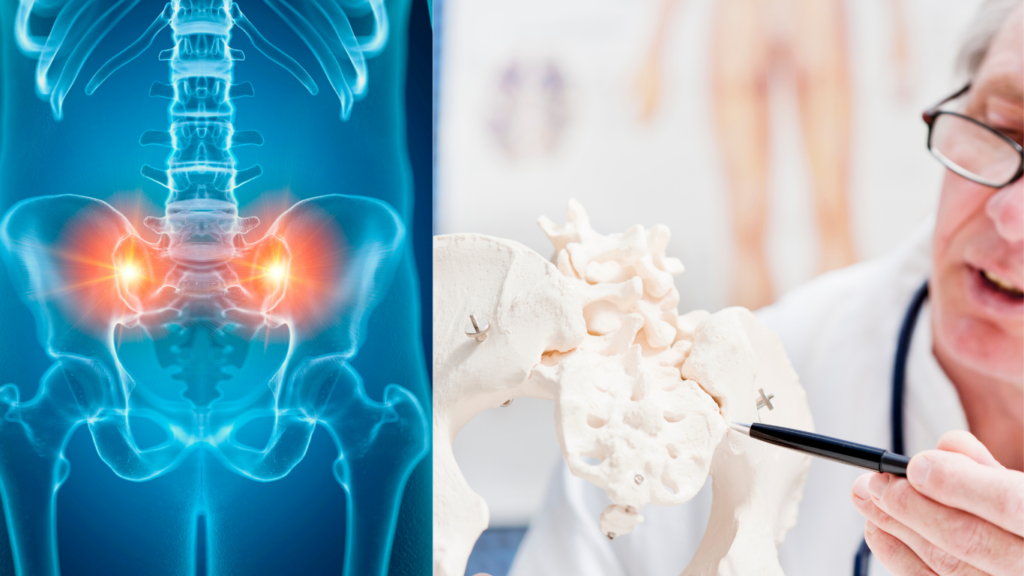Sacroiliac Joint Dysfunction & Pain Symptoms Causes Treatment
Constantly feeling Lower Back or Leg Pain? Is it Radiating downward to your legs as well? Sacroiliac Joint Pain can cause Leg or Lower Back Pain. This is one of the most common causes of lower back pain. sacroiliac joint dysfunction is also associated with leg pain or any symptoms such as weakness in the lower limbs.

The Leg Pain due to SI Joint dysfunction is a little difficult to diagnose from the radiating leg pain due to Disc Herniation or any compression on the sciatic nerve in the Lumber Region of the Spine.
As a holistic approach, chronic lower back pain is considered a Multi-factor Disorder with several etiologies/causes. Pain can be originated in the Different Structures of the Spine.
The structures, through which the Pain can arise, may include the following;
the intervertebral disc,
sacroiliac joints
nerve roots,
vertebrae facet joints,
spinal cord issues,
muscles and ligaments issues.
We have to use different Diagnostic Techniques to distinguish the Pains among all to find out the root cause of pain.
Anatomy of Sacroiliac Joint:

The Sacroiliac SI Joint is a form of Synovial Joint in nature (a Joint filled with a Fluid in its joint cavity containing a fibrous capsule Inside). Hyaline Cartilage is found in it. This joint develops in the 13th week of the Embryonic Stage and gets firm in the 16th week of Gestation.
Sacroiliac Joint is very well defined anteriorly, it is suspended by several Ligaments from the posterior Side. The Sacrum Region is a well-focused Triangular Region Consisting of 5 Vertebras fused between the 2 Pelvis Bones.
The SI joint is covered by 1.5 mm Hyaline Cartilage. Some amount of Synovial Fluid is also Present in it. The joint is formed by the fusion of Iliac wings and Sacrum Bone of the hip. It is located at the base of vertebral Columns. It shares all the Muscles with the Hip Joint.
Its also termed a weight Bearing Joint. The attachments of the Ligaments also play a very Vital Role in the strength of the SI joint. The Muscular attachments play a significant role in the stability of the Pelvis. In Short, the SI Joint is considered the strongest Joint as some Muscles Ligaments, and Joints play a creditable role in its Placement.
Symptoms ;
Mostly People get confused about their Pain signs, which could also be thought of as a similar symptom of SI joint Dysfunctioning. Pain due to SI Joint Dysfunctioning can mimic Radicular Pain or discogenic Lower Back Pain as well.
The LBP cannot be overlooked in this scenario. So for the same reason, a strong differential diagnosis needs to be made. Some of the Signs and Symptoms areas mentioned;
Radiating Pain; A Dull Pain is felt near the Hips, Groin, and Buttocks Region. Mostly the SI joint Dysfunctioning Pain is felt near the Buttocks Region, radiating upwards towards the Back or the Thighs and Pelvis. The pain is felt on One side normally, but it can be felt on Both Sides as well.
Lower Back Pain LBP; An Aching, dull, and diffused Pain is felt at Back. It can range from Mild, Moderate to even Severe in Chronic Cases as well. It is normally felt on a single side, But if it's getting worse, It can also Spread to Both Sides.
Stiffness; A hardened feeling is felt at the affected side, Reduced ROM (Ranges of Motion) is also observed which makes one unable to move their legs and back according to their Ease. You may feel difficulty while banding, twisting your waist, walking up, and climbing with any upward motion. A stiffness is felt at Pelvis, Lower Back, Groin Region, and Legs as well.
Like-Sciatic Pain; The Back and Buttocks feels Sharpened, Stabbing and Hot. It may also include Tingling and Numbness to one side or on Both Sides as well. SI joint Dysfunctioning may give Sciatic Like Pains which radiates down to the Knee if worsens.
Worsening Pains; Continuous Pressure is exerted on the SI joint, is felt, whenever you perform any task like Running, Jogging, Climbing the Stairs, Putting weight on one side or Both Sides, or even in Lying Posture.
Instability of Joint; The SI joint Dysfunctioning Pain would give a sensation as you are staggering to one side or it would buckle up even when you are standing, Moving, Walking, Jogging, Running, or Climbing.
If the SI joint Dysfunctioning is aggravated, it would result in inflammation of the Joint. It is also termed Sacroiliitis. It would be symptomatic as Stiffness, Pain, or many other symptoms.
What is the Pattern
SI joint Dysfunctioning is accepted as a source of Buttock or LBP(Lower Back Pain) which may or may not include Extreme Pains. By recent researches and Journals, SI joint Dysfunctioning normally shares the Pain of its Muscle with the Hip Joint anatomically and biomechanically respectively. As the structures surrounding SI Joint are merged together, so it cannot pain alone. It may be subjected to a Uni-Directional Pelvis Shear, Torsional or Repetitive Forces, which can also be associated with the Pain of SI joint Dysfunctioning.
Do You Know that? facts about Sacroiliac Joint Pain
The studies and researches show that sacroiliac SI Dysfunctioning contributes to lower-back and lower-extremity pains in about 3% to 9% of the overall patients. The Researches are evaluating the prevalence of SI pains in a very specific population. SI joint Dysfunctioning has been accepted as a strong potential one of the sources of Buttock or LBP(Lower Back Pain) which may or may not include Extreme Pains.
Causes for Sacroiliac Joint Dysfunction
SI Joint Dysfunctioning and its Pain can be due to any acute Injury or any Chronic Trauma which may include the following ;
- Heavy weight lifting
- Prolonged Sitting or lifting
- Bending at the Wrong Angles
- Tensional strains
- Falling onto a buttock
- Motor-vehicle accidents at the Rear Ends
Apart from all the above-mentioned reasons, it may be caused due to additional Torsional Strains upon the SI Joint associated with Bowling, Golf, Skating, Constant Lying or Sitting, bending on the affected side, or any other related stress.
It is also Observed that SI Joint Pain can also be enhanced and aggravated due to the following Postures;
- Constant Sitting on the Affected Side
- Long Term Lying on the Affected Side
- Weight Bearing on the affected Side.
- Standing Position and Forward Flexed
- Long term Standing with Fully Extended Knees
- Valsalva Maneuver
Musculoskeletal Cause
- Ankylosing Spondylitis
- Muscle Strain
- Herniated Nucleus Pulposus
Inflammatory Cause
- Pyogenic Sacroiliitis
- Sickle Cell Anemia
- Inflammatory Bowel Disease
- Genetic Disorders
- Eosinophelic Granuloma
- Reiter's Syndrome
- Osteochondroma
- Psoriatic Spondylosis
- Retroperitoneal Fibrosis
- Diffused Idiopathic Skeletal Hyperostosis
Medical Cause of Sacroiliac Joint Dysfunction
- Pituitary Disease
- Fibromyalgia
- Osteoporosis
- Abdominal Aneurysm
Malignancy Cause of Sacroiliac Joint Dysfunction
- Ovarian Cancer
- Intraspinal Neoplasms
- Metastases
- Lymphoma
- Carcinoma of Colon
- Prostate Carcinoma
- Polymyalgia Rheumatic
- Multiple Myeloma
Management of Sacroiliac Joint:
The Evaluation of the Patient is really necessary which is made through proper History Taking, Physical Examinations, and Perfect Medical based Decision Making from the patient's symptoms.
There are several Medical ways to evaluate the Patient and diagnose its SI Joint Dysfunctioning. It may differentiate from Textbooks to Textbooks & Physicians to Physicians as well.
Symptoms, Chief Complains, History of Medical and Surgical Illnesses, Review of the holistic Systems of the Patient, Present Past and Family Histories related to diseases, Social Status of the Patient, Working Nature and all other Physical Examinations are significant to inquire from a Patient, which Plays a very credential role in Medical Decision Making.
Treatments of SI Joint pain:
Some treatments had been applied to treat the Pains associated with SI Joint Dysfunctioning.
These Treatments range from Osteopathic Therapies, Medical, Physical, and Manual Therapy Treatments, Orthotics, Manual Mobilizations, cryoneurolysis, Thermoneurolysis, Radio Frequencies, TENS, Ultrasounds, Neuroaugmentations, and Surgery.
Some of those treatments which really proved beneficial for the Patients had been enlisted below;
- Physical Therapy and Exercises:
The effects of Manual and Physical Therapies have shown valuable results on SI Joint Dysfunctioning Pains. Stabilization Exercises, Aerobic Exercises, Restoration Exercises for achieving lost ROM Ranges of Motions. Most of the Physical Therapy treatments have focused on the
- Pelvic Stabilizations.
- Correction of Gait Abnormalities
- Restoring Postural Deformities
- Correcting Dynamic Muscle Imbalances
Every person comes with different Clinical Symptoms and Complaints. These may range from specific Trance, Weakened SI Joint Dysfunctioning, or Muscles Tightening of Lower Extremities. It may Include many variable Muscles, including quadratus lumborum, iliopsoas, piriformis, hamstrings and gluteus maximus/Minimus, etc.
Following Exercises Play a very Vital Role in Relieving SI Joint Dysfunctioning associated Pains;
Muscle Stretching Exercise: Stretching helps relieve the tension of the Muscles in the SI Joint Region. The Strain in the gluteus maximus, hamstring muscles, piriformis, and Pelvis Muscles can be relieved through these stretching exercises. 10 Sets of 5 Reps are enough at the initial stage.
b. Sacroiliac Joint Muscles Strengthening exercises: It's better to support your Sacroiliac Joint Muscles through Strengthening exercises. It not only strengthens the SI Muscles but Abdominal and Trunk Muscles too.
- Press Up Exercise: Lye down and raise your upper body till your arms are fully extended on grond. Hold for 20 Sec and release.
- Single Knee to Chest Stretch: Lye Supine and raise one of your knee to the level of knee to Chest. 10 sets of 3 Reps.
c. Aerobic Exercises: for Sacroiliac Joint Dysfunction
- Lunges Exercises
- Burpees Exercises
- Jump Squats
- Side Kicks
- High Knees
- Stair Climbing
- Jumping Jacks
- Mountain Climbing Exercises
These Exercises help to elevate the Blood Flow and bring about the nutrients and other oxygen supplements to the affected Tissues. It is necessary for the Healing Process of Damaged Muscles.
d. Hip Abduction Strengthening: for Sacroiliac Joint Pain
The Hip Abductors help to connect to the Thigh Muscles firmly.
It helps to sustain a balance between the pelvis and core Region. It also aids in Reducing the Staggering Gait Pattern. 10 sets of 15 reps.
e. Bridging Exercises: for Sacroiliac Joint Pain
It is considered one of the most effective forms of Exercise in Physical Therapy Treatment. Lye down on matt, rest your back by your Shoulders and do 10 sets of 3 reps each.
Manual Therapy Treatments can be advocated as a fruitful treatment of SI Joint Dysfunctioning and stabilization. Some Studies also Showed that Manipulations do not change the actual position of the sacrum, related to the ilium. Most of the Studies illustrated the beneficial results of Manual Therapy treatments for SI Joint Dysfunctioning and Pain.
- SI Joint Dysfunction and Role of Interventions:
SI Joint Dysfunction is treatable with Physical and Medical Treatments. These Physical Treatments also Include Interventions Treatments.
The standards interventions in Physical Therapy (PT) include
- Manipulation
- Manual joint mobilization bracing
- Patient education
- Massage
- Aerobic conditioning
- Electrotherapeutic interventions
- Therapeutic modalities i.e heat, TENS, ultrasound, etc.
Other Interventions to Treat SI Joint Dysfunctioning includes
- NSAIDs Non-Steroidal Anti Inflammatory-Drugs
- Corticoid-Steroidal Treatment through Injections
- Osteopathic Manipulation
- SIJD (Sacroiliac Joint Dysfunctioning) Belts
- Radio-Frequency Denervation
- Last option for Surgery.
The Patient may respond to one of the Interventional Treatments or the combinations of two or three. It all depends on the condition of the individual Patient.
- Preventions :
Below mentioned conditions can lead your health to devastation. Avoid Following lifestyle patterns to prevent Si Joint Dysfunction.
- Prolonged sitting
- Lying Supine
- Resting, without changing postures
- Reduction in Physical Activity/Sedentary Lifestyle
The prescription should be made regarding the Counter Pain drugs and NSAIDs. Heat and Cold Packs can also work, applying on the LBP & Upper Buttocks. Stretching, Meditation, YOGA can also help in preventing the Pain Conditions to worsen.



